March 18, 2016
Air Date: March 18, 2016
FULL SHOW
SEGMENTS
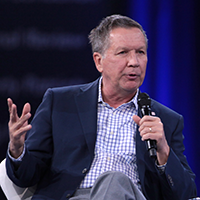
Where Kasich Stands on Climate Change
View the page for this story
After winning his home state of Ohio, Governor John Kasich remains far behind in the delegate count, but is still in the running, and now holds bargaining chips for the Republican convention in July. At a recent CNN Republican debate Governor John Kasich declared humans contribute to climate change and that reducing emissions can create jobs, and help the economy. (02:00)
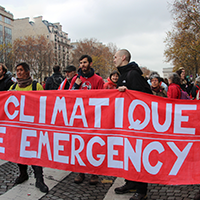
Network TV Cuts Climate Change Coverage
View the page for this story
From the Paris Climate Agreement to the Pope’s environmental encyclical, 2015 should have been a banner year for climate change in the media. But a recent report from Media Matters for America documents a recent decline in commercial network TV global warming coverage. Andrew Seifter from Media Matters discusses the trend with host Steve Curwood. (08:10)
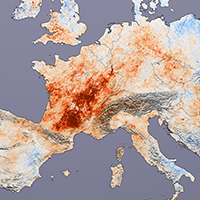
Does Climate Change Cause Extreme Weather?
View the page for this story
Scientists have long avoided attributing specific extreme weather events to climate change, but a recent report from the National Academies of Sciences, Engineering and Medicine suggests that some extreme weather events can be attributed to climate change with a high degree of confidence. Host Steve Curwood talks with Penn State professor and former Navy Admiral David Titley, chair of the report’s committee. (08:20)
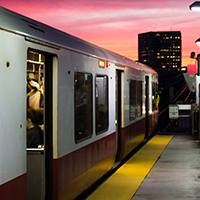
Late Night Workers Stuck On the Platform
/ Jaime KaiserView the page for this story
Boston's late night weekend transit service is about to come to a grinding halt, leaving some service workers and other residents wondering how they'll get home after midnight. Living on Earth's Jaime Kaiser spoke with riders and transportation officials about the cutback and has the story. (05:45)
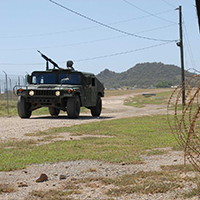
Beyond the Headlines
/ Peter DykstraView the page for this story
This week features a proposal to turn Guantanamo Bay into a marine reserve, and reports of a low point for the number of U.S. oil and gas rigs in operation. Then Peter Dykstra and host Steve Curwood look back on the real-world Flat Earth Society. (04:30)
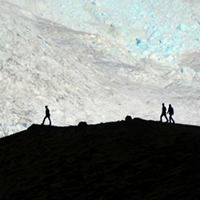
Big World, Small Planet
View the page for this story
From global warming to water shortages, humans are beginning to push up against a few fundamental planetary boundaries. Johan Rockström is a professor of environmental sciences at Stockholm University in Sweden and author of the book Big World Small Planet. He tells host Steve Curwood that humans can continue to grow and develop, as long as we respect key planetary limits. (16:40)
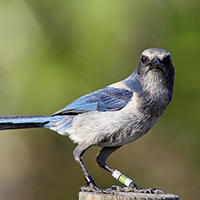
BirdNote: The Florida Scrub-Jay
/ Michael SteinView the page for this story
Thousands of years ago, higher sea levels isolated much of Florida from the mainland, and the Florida Scrub-Jay evolved into a unique species found nowhere else. BirdNote’s Michael Stein reports on the habits of this rare bird and the threat of habitat destruction that it faces. (01:55)
Show Credits and Funders
Show Transcript
HOST: Steve Curwood
GUESTS: Andrew Seifter, David Titley, Johan Rockström,
REPORTER: Jaime Kaiser, Peter Dykstra, Michael Stein
[THEME]
CURWOOD: From Public Radio International, this is Living on Earth.
[THEME]
CURWOOD: I'm Steve Curwood. Global warming and television, despite major news events, last year most US networks gave this existential threat less airtime, with one exception.
SEIFTER: Fox actually...their coverage doubled but that wasn’t a good thing for people who are concerned about climate change because the vast majority of their coverage included attacks on climate policies, or climate science denial.
CURWOOD: Why this is a difficult subject to cover and the harm to public awareness. Also, why cutting late night services on public transit is a bad deal for some low-wage workers.
RM1: I think the stereotype about late night service is that it exists for student who are drunk and can’t drive home. The reality, however, is that it is for late shift workers, the way for them to get home, and therefore really important.
CURWOOD: That and more this week, on Living on Earth. Stick around.
[NEWSBREAK MUSIC: Boards Of Canada “Zoetrope” from “In A Beautiful Place Out In The Country” (Warp Records 2000)]
ANNOUNCER: Support for Living on Earth comes from United Technologies – innovating to make the world a better, more sustainable, place to live.
Where Kasich Stands on Climate Change
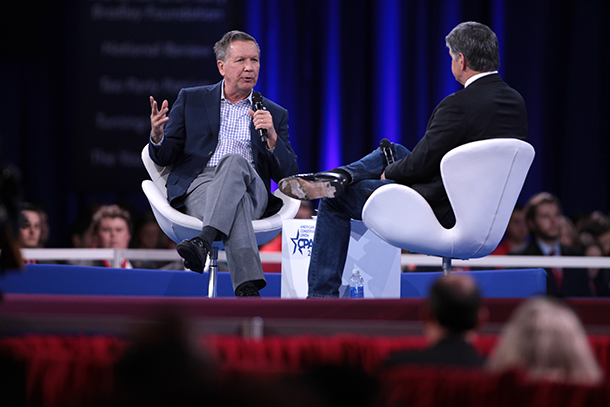
Ohio Republican Governor John Kasich talks with conservative radio host Sean Hannity at the 2016 Conservative Political Action Conference. (Photo: Gage Skidmore, Flickr CC BY-SA 2.0)
[THEME RETURN]
CURWOOD: From the Jennifer and Ted Stanley studios at the University of Massachusetts Boston and PRI, this is Living on Earth. I’m Steve Curwood. Back when contested political conventions were the usual way parties nominated their presidential candidates, states would often send a “favorite son” armed with that delegation’s votes—good for trading, or even winning. Now the old is new; since Ohio Governor John Kasich beat Donald Trump to win his state’s Republican primary he’s gained enough “favorite son” delegates to position himself as a compromise candidate and make it much harder for Mr. Trump to sweep unchallenged to the GOP nomination. As a Republican presidential candidate Mr. Kasich has stood out as the one most likely to take some actions on climate change. Here’s what he said in a recent debate broadcast by CNN.
[APPLAUSE]
KASICH: I do believe we contribute to climate change but I don’t think it has to be, you know, either you’re for some environmental stringent rules or, you know, you’re not going to have any jobs. The fact is you can have both. In our state we’ve reduced emissions by 30 percent, and let me tell you also what we’re trying to do. We want all the sources of energy. We want to dig coal but we want to clean it when we burn it. We believe in natural gas, we believe in nuclear power, and you know what else I believe in? I happen to believe in solar energy, wind energy, efficiency. Renewables matter. Now, it doesn't mean because you pursue a policy of being sensitive to the environment, because we don’t know how much humans actually contribute, but it is important we develop renewables. Battery technology can unleash an entirely different world, so the fact is you can have a strong environmental policy at the same time you have strong economic growth. They are not inconsistent with one another.
TAPPER: Thank you, Governor.
KASICH: CNN’s Jake Tapper with John Kasich, who benefitted from many Democratic votes to win the Ohio Republican primary.
Related links:
- Ohio’s renewable energy portfolio standard
- Biz Journal: Ohio’s renewable energy freeze needs to stop, Kasich administration says
- New York Times: Marco Rubio and John Kasich Illustrate Republican Divide on Climate Change
Network TV Cuts Climate Change Coverage
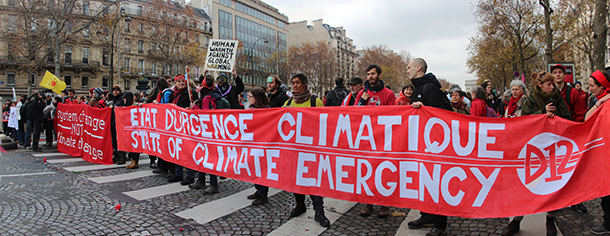
While protests and the Paris climate talks in November 2015 drew international attention to climate change, 2015 saw a decline in US network television coverage of climate change compared to 2014. (Photo: Takver, Flickr CC BY-SA 2.0)
CURWOOD: 2015 was a big year for climate news, but you wouldn’t know it from commercial television network news. Despite such major stories as the President’s Clean Power Plan, the Paris Climate Agreement, and the Pope’s encyclical on climate change, on average NBC, CBS, and ABC all cut coverage of global warming. Media Matters for America has been monitoring climate coverage for the last few years, and Andrew Seifter is its Climate and Energy Program Director and a co-author of this year’s study. Thanks for joining us, Andrew.
SEIFTER: Thanks for having me on, Steve.
CURWOOD: So talk to me a bit about this study. Now you been looking at climate change in the media since, what, 2009? What did you find this year?
SEIFTER: Well, we found that the total amount of coverage on the nightly newscast and the Sunday shows combined was down five percent from last year which was certainly a surprising finding given that, I think, by any measure we could say that 2015 was most newsworthy year for climate change in history.
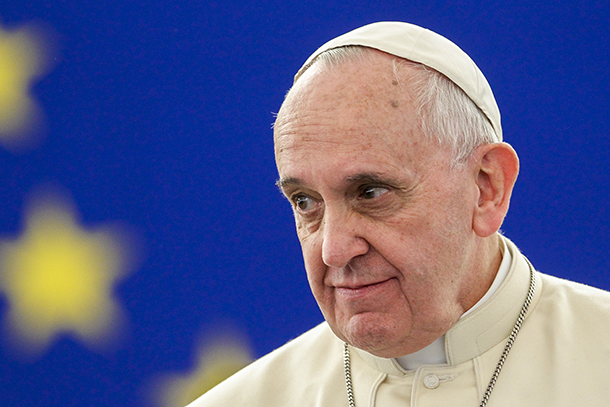
In 2015 Pope Francis published an Encyclical on climate change and our relationship to the natural world. (Photo: Martin Schulz, Flickr CC BY-ND-NC 2.0)
CURWOOD: So which network dropped it the most?
SEIFTER: ABC really stood out in that regard. They had a 59 percent drop in their coverage. They dedicated 13 total minutes all year long to climate change coverage. And just to put that in perspective, you know, their Sunday show this week had Bernie Sanders on several times and he actually brought up climate change on his own four different times; whereas the host and reporters of this week only brought up climate change twice all year, so Bernie Sanders, even when he wasn't even asked about climate change brought it up twice as often as the journalists themselves.
CURWOOD: So this seems very strange in a year that, what? You have the Pope with a major statement, an encyclical on climate change, the Paris climate talks, and there's finally an agreement there. There's been this investigation of Exxon. What's going on?
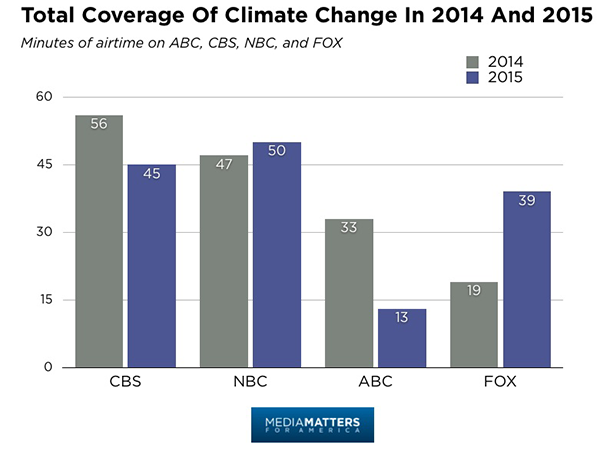
Total coverage of climate change in 2014 and 2015, based on minutes of airtime on major news networks ABC, CBS, NBC, and FOX. (Photo: Media Matters for America)
SEIFTER: Well, you know that's the conversation...that is a very important question and that's the conversation we were hoping to provoke with our study where we lay out the facts and then we can sort of try to interpret that data. I think one explanation without question for the year-to-year difference is the presidential campaign. In the modern age, the presidential election starts the day after the midterm elections end, and particularly I think with the candidacy of Donald Trump, the media have devoted so many resources to covering him, that's really taken a lot of the oxygen out of the room, but I think there's also the broader issue that climate change coverage in general is never that high. Sam Stein from the Huffington Post was on Bill Maher the other night, and he talked about how climate change is a gradual menace. For example, in Florida, where sea level rise is a real threat and is already occurring, it just doesn't have the same shock value as a terrorist attack or a mass shooting, you know, these types of events we see that draw these massive waves of media coverage and with climate change, it really requires journalists to dig a little deeper and to explain the nature of the threat to their viewers more than some of these events that speak for themselves.
CURWOOD: Now, you said ABC had the deepest decline in coverage. What about the other networks? Do they come close to that?
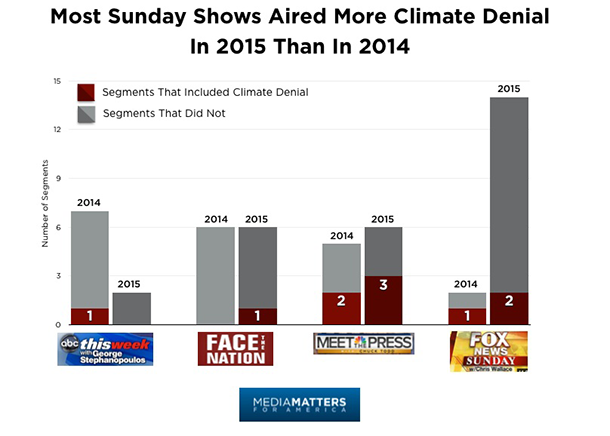
Climate denial segments featured on Sunday shows rose from 2014 to 2015. (Photo: Media Matters for America)
SEIFTER: You know, I think CBS and NBC kind of stayed generally where they were before. FOX actually, they were the one network that significantly increased their coverage. Their coverage actually doubled, but that wasn't a good thing for people who are concerned about climate change because the vast majority of that coverage included attacks on climate policies or climate science denial, so people who watch Fox for their climate coverage got more of it but they didn't necessarily learn more from watching it.
CURWOOD: What about the other networks, and who increased coverage?
SEIFTER: PBS has sort of stood out for a couple years in terms of just the quality of their coverage. You know, they did more segments on climate change than all of the other nightly news shows combined. So, PBS really stood out. I would say also that NBC and CBS did do a better job this year of connecting the dots between extreme weather events and climate change. That was one particular area where those two networks did an excellent job, but the broader problem we see is that the polling constantly shows that the vast majority of the public believes climate change is real and that humans are causing it, and they support actions to address climate change, but what we find over and over again is that it's just not a top-of-mind issue for people. They don't prioritize climate change compared to other issues and I think a big reason for that is because the media is not talking about the impacts of climate change on a day-to-day basis, and we found in our study that the national security impacts of climate change were largely ignored by the networks; the economic impacts were largely ignored and the public health impacts as well, even though the Obama administration specifically made it a point to emphasize public health when they rolled out the clean power plan, which is the biggest action the US has ever taken to fight climate change. So despite a lot of newsworthy events and reports about those impacts, it didn't make it onto the network newscasts.
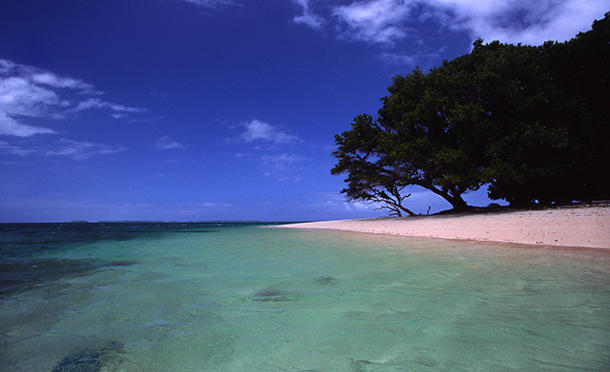
Although climate change gets little attention on major commercial TV networks in the United States, it’s become an urgent matter in countries like the Marshall Islands, where sea level rise threatens the existence of towns and communities. (Photo: Stefan Lins, Flickr CC BY 2.0)
CURWOOD: How important is commercial television? We have blogs, podcasts, the internet, Facebook. All these things have changed the media landscape. How important is that the commercial broadcast television networks aren't covering climate to the extent that I think your organization thinks that it ought to?
SEIFTER: Really the Sunday shows have a particular influence on the conversation that occurs in Washington and throughout the country. You know, they really set the policy agenda for the week, and I think that those conversations, they make news, you know, so I think the things that are talked about on the Sunday shows have an added impact. It's not just the coverage they get that day when people are watching, those quotes get covered in subsequent news reports both on television and in print media. So we felt that really they deserve particular attention.
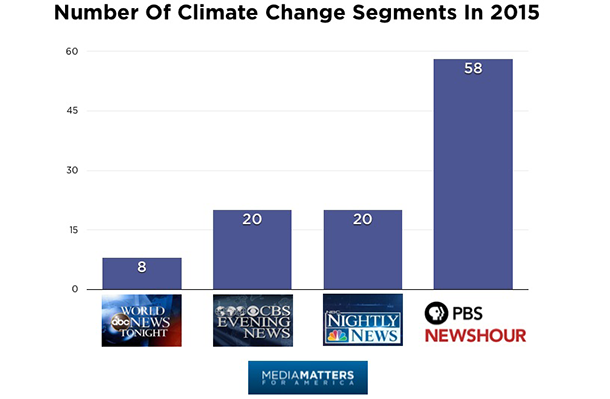
Comparison of network climate coverage: ABC’s World News Tonight, the CBS Evening News, NBC’s Nightly News, and the PBS Newshour. (Photo: Media Matters for America)
CURWOOD: What is the cost to American society that the network television shows and Sunday morning talk shows have cut back on the coverage of climate disruption?
SEIFTER: I think it's a big explanation for why we have been so slow to act on climate change, you know. I think if there had been ample climate change coverage in the run-up to, say, the debate in Congress over the cap and trade legislation in 2009 and 2010, I think there would've been a lot stronger public support for getting something done on the issue and it would've been a lot harder to vilify the legislation and make the supporters of it seem like they were trying to harm taxpayers. You know, I think people need to know, the public needs to know that climate change is already impacting their lives in significant ways and that it will continue to impact their lives and the lives of their children and grandchildren, and I think it's really the obligation of the media to tell that story and inform the public about these threats.
CURWOOD: Now, here at Living on Earth, of course, we cover climate change a fair amount. In fact, sometimes we have a sense of climate change fatigue. What do you recommend to news organizations that are focusing on this, well, let's face it, very depressing topic?
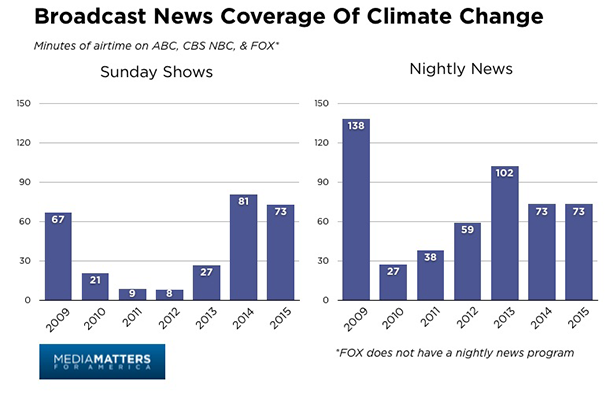
Climate coverage since 2009 (Photo: Media Matters for America)
SEIFTER: That's true, and I do think there are...research has shown that if you are too dour about the issue, you'll turn a lot of people off and people don't want to hear about a hopeless situation. Fortunately, we are not yet at the point where it is a hopeless situation. 2015 was the biggest year for climate action in world history. It was a rare moment of international unity when you had 195 countries around the world all saying that this is a crisis that we're facing as a planet and that we are all have to come together to deal with this, you know. So I think you see folks on FOX News and other outlets trying to suggest that the US can't do anything because countries like China and India won't, but the simple fact is that China and India are stepping to the plate. The US is stepping to the plate. European countries are stepping to the plate, so I think telling that story is critically important. I also think that telling human stories of climate impacts is important to make it more than just about numbers and figures, but actually telling the stories of individual people, whether it be the victims of Hurricane Sandy or farmers or other people who are being directly impacted by wildfires and other issues. Telling their story, I think, is important for getting it across to people that there's a real human impact to what's happening.
CURWOOD: Andrew Seifter is Climate and Energy Program Director at Media Matters for America and co-author of the study "How broadcast networks covered climate change in 2015". Andrew, thanks so much for taking time with us today.
SEIFTER: It was my pleasure, Steve. Great conversation.
Related links:
- Check out the study on broadcast coverage of climate change
- Media Matters for America
[MUSIC: Ry Cooder and Manuel Galban, “Bolero Sonambulo,” Mambo Sinuendo, World Circuit Music/Hi-Lo Shag Music]
CURWOOD: Just ahead...the trouble with transit for late-night workers. Stay tuned to Living on Earth.
[CUTAWAY MUSIC: Kalichstein/Laredo/Robinson Trio, “Piece en forme de Habanera,” RAVEL: Works For Piano, Violin & Cello, Maurice Ravel, Koch International Classics]
Does Climate Change Cause Extreme Weather?
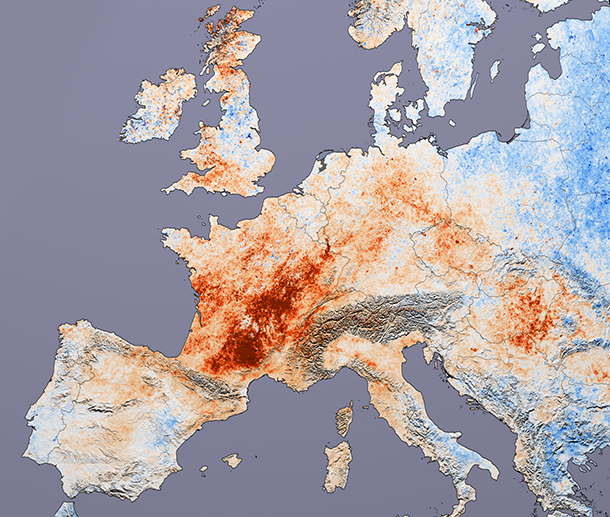
Europe’s devastating heat wave in 2003, shown with data gathered from July 1st to 31st. Dark red indicates areas where temperatures were 10 degrees Celsius above normal. Heat waves are among the easiest weather events to attribute to climate change. (Photo: Reto Stockli and Robert Simmon / NASA, based upon data provided by the MODIS Land Science Team)
CURWOOD: It’s Living on Earth, I’m Steve Curwood. Even as the weather becomes increasingly unpredictable, and extreme events become increasingly frequent, it’s considered scientifically incorrect to pin the blame for any one flood or drought or freakish snowstorm on global warming. But a new report from the National Academies of Science finds that it is now possible to estimate the influence of climate change on some types of extreme events, such as heat waves, drought, and heavy precipitation. We called up Retired Admiral David Titley, the former chief meteorologist for the Navy and now a professor at Penn State University, who chaired the committee that conducted the study. David, welcome to Living on Earth.
TITLEY: Well, thank you, Steve.
CURWOOD: So, just to be clear you not saying that we can now 100 percent link climate change to specific weather events, but what exactly does your report tell us?
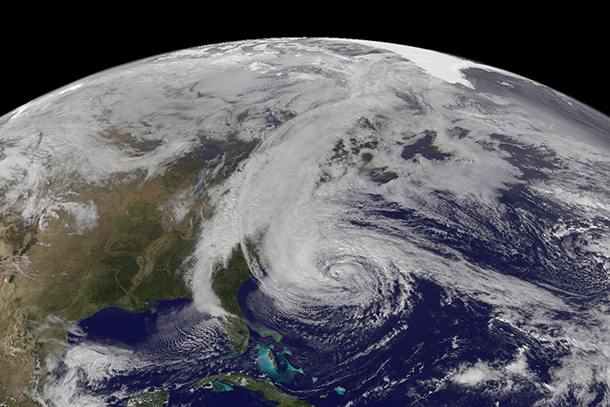
Hurricane Sandy bears down on the Eastern seaboard, October 28th, 2012. Hurricanes are among the most difficult weather events to attribute to climate change. (Photo: Robert Simmon / NASA Earth Observatory, with data courtesy of the NASA/NOAA GOES Project Science team)
TITLEY: So, we were asked to look at the science of attribution of these extreme weather events to any climate change and our report found that for some specific extreme events especially those that have to do with temperature such as heat waves and cold, or really lack of cold, we really have quite high confidence that for many of these specific events, we can state a link. For some heavy rains and flooding events, we can make that assertion with medium confidence. Hurricanes and typhoons, less confidence, and then by the time we get down to things like tornados and hailstorms, really almost no confidence in that.
CURWOOD: So, when you’re talking about an “extreme event,” it’s extreme because, what, it happens more often? It’s bigger?
TITLEY: So, extreme, could be, like, this is a one-in-a-hundred event. Extreme could be, in a 30 year record, maybe you’ve never seen this or only rarely seen this kind of event. There can be different definitions of exactly what is the criteria for “extreme,” but one thing they all contain in common is that, by definition, these are very, very unusual events.
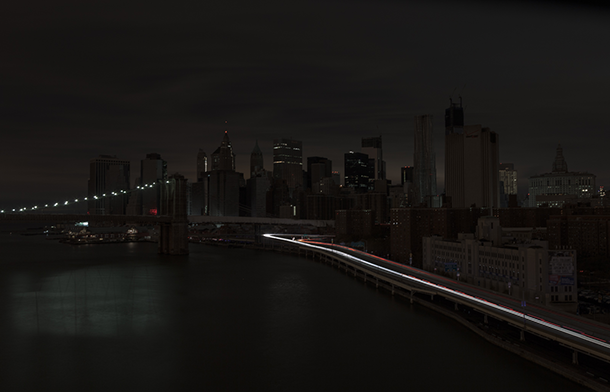
Hurricane Sandy left massive power outages in its wake, including in Manhattan. (Photo: Several seconds, Flickr CC BY-NC-ND 2.0)
CURWOOD: So why is it relatively easy to link, say, an extreme cold event, or extreme heat event, to climate change when it's just too hard to link something like a tornado or, say, a wildfire?
TITLEY: There are really three components that go into determining, you know, how confident scientists can feel when attributing these specific events, and I sort of think of it as a three legged stool, and the first leg is the physical understanding. Do we really understand how climate impacts that particular type of event? For heat, that's pretty easy. The fundamental physics of greenhouse gases are very, very well understood. On the other extreme, on the physical understanding, there's very little understanding of how climate may or may not affect a specific tornado or hailstorm. I mean, we just simply, we don't know. The second leg is, do we have long-term observations? Do we see these extreme events occurring more or less? And that is, you know, pretty good evidence if things are changing, if I have a good observational record. And the third and final leg of the stool is, can climate models accurately replicate or reproduce these extreme events? So, do we have the resolution, do we have the physics, all that kind of stuff that goes into these big climate computer models, and if the answer is “yes” for all three, like it is for the temperature related, the cold and the heat, we really feel quite confident.
CURWOOD: Let's go back to 2012 when Hurricane Sandy devastated so many communities along the eastern seaboard. How would event attribution change the response to an extreme weather event such as a Sandy?
TITLEY: Yes, so one of the things that I think our report makes clear is we're talking about the attribution of the hurricane itself. Now, if you start looking at the impacts of that storm, one of the, I think, almost indisputable climate related impacts is that the storm surge from Sandy came in on a higher baseline of sea level thanks to global sea level rise and it would've, let’s say, if Sandy had come in a century ago, and I think that answer is almost eight inches or so around the New York City area. As you get these very big surges they cross thresholds. It’s not just a little increment in the amount of damage they do, and of course a classic case for that is once you get to a certain level of water, you flood the New York City subway system. So when we talk about Sandy, I think it's important to realize that even if we cannot attribute the storm itself to climate, we sure know some of the impacts especially with surge on top of higher sea levels. It is a climate impact, and it is getting worse.
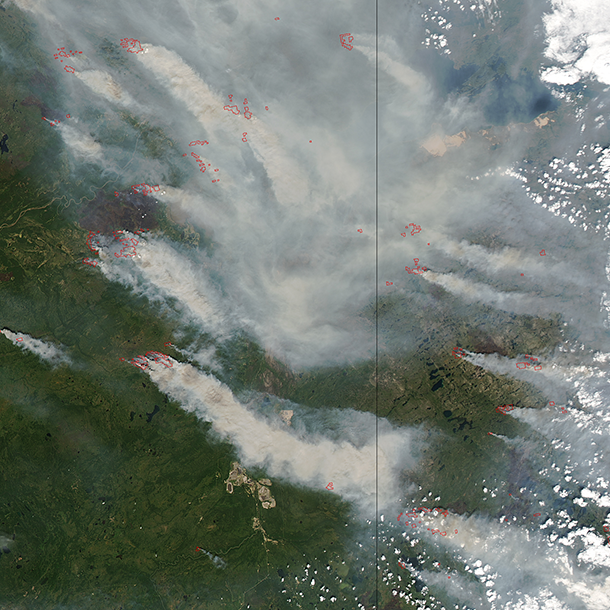
Wildfires burn in Alberta and Saskatchewan, June 28, 2015. Because of many contributing factors, including fire suppression, attributing wildfires to climate change is more difficult than for heat waves. (Photo: Jeff Schmaltz / NASA, LANCE/EOSDIS MODIS Rapid Response Team at NASA GSFC)
CURWOOD: Now, I know that some scientists who looked at your report said that this is great, but can you disentangle all this data? I mean, it's mishmash.
TITLEY: Well, it is quite complex, and any listener who is interested, if they actually go through our Chapter Four, we really talk in quite a lot of detail about each one of these specific types of events, whether they’re heat or cold or floods droughts, hurricanes, all the way down to tornadoes and regular everyday low-pressure systems. Each section really says, what do we know, what are the challenges and what are some opportunities for the way ahead? This is the first time that anybody has really tried to integrate this, and we are not saying that we can attribute every specific event to climate change - far from it - but we are also now not saying what many scientists, myself included, have said in years past of, while the climate is changing, we really can't say anything about any one event. So we're removing off that. If you, you almost think of, like this as is a baseball diamond, maybe we're down to first base now. You know, maybe we've, we've got off home plate, we're not just swinging at the pitches anymore, and maybe for heat we're even taken a look at second base there.
CURWOOD: Now, you're rounding first, huh? You're not just running over the bag.
TITLEY: For some events. Now, for the severe storms like the big thunderstorms and tornadoes, uh, we’re, we're still in the batter’s box.
CURWOOD: This improvement in understanding how climate change affects extreme weather events is clearly going to be very useful, but it is kind of depressing, if you think about it. We're getting better at estimating how bad, how devastating future weather events might be. What's the message of hope here?
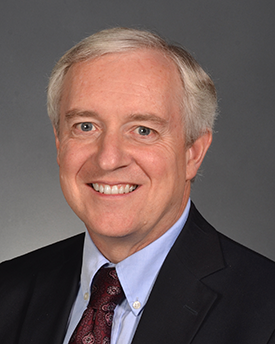
Adm. David W. Titley is a Professor of Meteorology and Founding Director of the Center for Solutions to Weather and Climate Risk at Pennsylvania State University. Now retired from the Navy, he initiated and led the US Navy Task Force on Climate Change. (Photo: courtesy of David Titley)
TITLEY: One of the things I get hopeful about is that we're seeing more and more different segments of society saying, “Guys, we need to pay attention,” all the way from people like Hank Paulson. I mean nobody's accusing Hank Paulson of being a bleeding-heart, tree-hugging liberal. He was, you know, Secretary of Treasury for Bush 43. He's a Goldman Sachs businessman, but he sees that this climate as a real danger. We have the medical community, increasingly the health community; we have the religious community, evangelicals who see that this is an affront on God's Earth. The insurance companies are increasingly seeing this as an issue, so I see, like, our report as just another piece of evidence. Some people may say, well, climate was kind of abstract, it was out in the future, but now I start to understand when I see a specific event that that really is in fact that early face of climate change. There is a momentum building, maybe not in all places in our political system, but in many other places that we're going to have to come to grips with this problem and the other part that really makes me optimistic is that, when Americans put their mind to it, we do incredible things. We've done that for World War II. We did that, like, say, for Apollo. Americans do amazing things when we are focused, and I truly do believe, and this is a belief system for me, but I believe that we will get focused in overcoming this challenge and providing a world that, you know, future generations will be happy to inherit.
CURWOOD: Admiral David Titley is the Founding Director of the Center for Solutions to Weather and Climate Risk at Pennsylvania State University. David, thanks so much for taking the time with us today.
TITLEY: Thank you, Steve. It was a pleasure being here.
Related links:
- Download a PDF of the report, “Attribution of Extreme Weather Events in the Context of Climage Change”
- Commentary from one of the report authors: “Links between climate change and extreme weather are increasingly clear and present”
- Center for Solutions to Weather and Climate Risk
- NOAA Sea Level Rise Viewer
- About David Titley
[MUSIC: The Walkabouts, “The Train Leaves at Eight,” Train Leaves at Eight, Mikis Theodorakis, Innerstate Records]
Late Night Workers Stuck On the Platform

An MBTA red line train at the Charles/MGH stop. (Photo: Andrea Monari, Flickr CC BY-SA 2.0)
CURWOOD: When the weekend comes restaurants and clubs stay open late, and that means their service workers have to find a way home well after midnight. New York City runs public transit all night long, but New Jersey Transit and the Metropolitan Boston Transit Authority are now ending key late night services, leaving riders in the lurch. Some 13,000 Boston riders took advantage of the late night service, but the deficit-ridden MBTA Fiscal Management and Control Board says it was too expensive. Living on Earth’s Jaime Kaiser headed underground as one of the very last, late night subway trains left the station and has our report.
[SOUND OF SUBWAY TRAIN]
JK: Park Street is Boston’s busiest late night station, but only a few people are waiting on the platform at 1:30 on a Sunday morning, and many are less than pleased with late-night changes to the T, as Bostonians call it.
RIDER 1: Well I’m a Chef at Curry College. I’m gonna be greatly affected by the cutback in late-night service because I get out of work at 12:30. The bus is usually there within 20 minutes to get me home, but to take me to walk it’ll be an hour and 40 minutes. It’s so dangerous walking through. People get shot. People die over on Hyde Park Ave, and I have to walk all the way up at night.
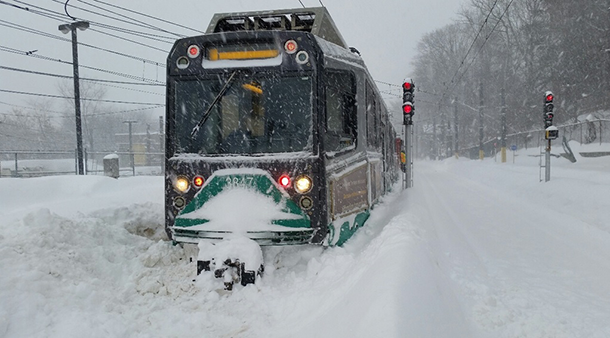
Last winter heavy snow caused delays on Boston’s transit system. (Photo: MBTA)
RIDER 2: I think it’s a little frustrating because, for example, I’m coming from my cousin’s place in Brookline right now and if I go to his house in the future now I’ll either have to leave earlier or I’ll have to drive to his place earlier in the evening. It’s just annoying compared to having the T open, you know?
JK: Opinions from T riders like these weren’t enough to dissuade the MBTA from axing the program. Monica Tibbits–Nutt, a member of the MBTA Management and Control Board, explained why the board decided to end the late-night service.

Monica Tibbitts-Nutt serves on the MBTA’s Fiscal and Management Control Board. (Photo: MBTA)
TIBBITS-NUTT: The project did not have metrics established beforehand to say whether it was going to be successful or not, and that’s in general not a way to operate a pilot project. So for me, the way I looked at it, I terminated an operation, not the concept of late-night service but this particular operation.
JK: It was the design that was faulty, she said. The late option didn’t work for many workers who get off after 2:00 A.M., and early-morning trains are perhaps just as necessary for low-income workers. But whatever the design, the MBTA’s in trouble. The Federal Transportation Administration – the FTA – wrote to them telling them to complete the equity analysis. It’s a federal regulation that says local transit systems must assess whether major service changes will disproportionately impact minority or low-income riders. The T began that analysis and preliminary data suggested that the cuts would indeed affect low-income riders, but that report was never completed.
TIBBITS-NUTT: If you have a major service change, you have to do an equity analysis. If you just end a pilot, you don’t, and the question is, this was a pilot project, but it was a pilot project that went beyond 12 months. As you’ve seen from the FTA’s letter they disagree with that and so now we will be doing the equity analysis and we've been performing the equity analysis since we received that letter.
JK: Advocates say the MBTA should take account of low-income workers in its planning. Rafael Mares is the Vice President of the Conservation Law Foundation.
MARES: I think the stereotype about late night service is that it exists for students who are drunk and can’t drive home but the reality however, is that it is, for late shift workers, the way for them to get home, and therefore really important.

Rafael Mares is Vice President and Director, Healthy Communities and Environmental Justice at Conservation Law Foundation. (Photo: Conservation Law Foundation)
JK5: Until the MBTA completes the analysis it’s difficult to measure the scope of the problem. Some late-night workers are undocumented, and many have limited English. But we did hear from a man we’ll call Luis, a long-time, late-night chef from El Salvador who had enormous problems trying to getting home without late night service. He sent a written account, and we’ve translated his words.
LUIS: Finally I saved up and bought a moped. A few months later a car hit me, and I ended up in the hospital, then in rehab, then a surgery. The vertigo was bad, and I couldn’t work. Then more weeks of outpatient rehabilitation. Then the moped’s lock was cut, and it was stolen, so I got a bicycle. Actually several bicycles, one at a time, as each one was stolen from work. It was hard to peddle 10 miles after my double shift in the kitchen, so I bought another moped. One night it was snowing when I left work, an unexpected storm, and my moped skidded into a fall. This time I was out of work for a few months with a broken leg, surgery, and physical therapy. Finally my wife and I moved to a new town with a lot of restaurants, where I could walk to work.
JK: And when people have to find alternatives to public transit, the climate suffers too. Rafael Mares from the Conservation Law Foundation again.
MARES: The greatest greenhouse-gas emissions come from the transportation sector. In Massachusetts it’s almost 40% of our greenhouse gas emissions. As a result it’s really important that we have a transportation system that allows people to get around in ways that doesn’t require driving.
JK: Boston announced the late-night service back in 2014 with great fanfare, claiming the change would put the T on par with international cities like Paris and Moscow. Now, Monica Tibbits-Nutt says the MBTA has higher priorities like upgrading its defective, 100 year-old signal system and countless repairs. Perhaps that will help the system cope with the kind of snowstorms that last winter often brought the T to a grinding halt.
For Living on Earth, I’m Jaime Kaiser in downtown Boston.
[SUBWAY SOUNDS]
Related links:
- The Massachusetts Bay Transit Authority on ending late night service
- Boston Globe: T Forced to Consider Late Night Service alternatives
- About Rafael Mares of the Conservation Law Foundation
Beyond the Headlines
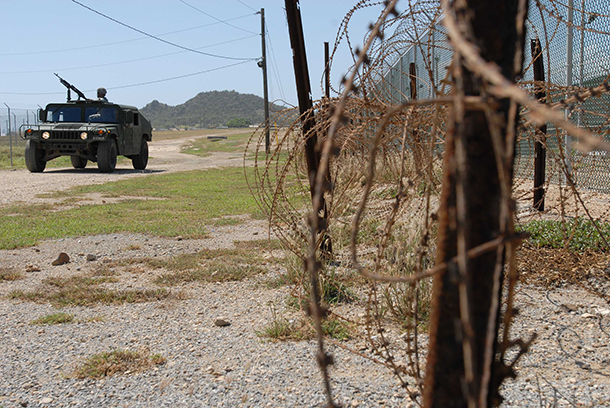
A novel idea proposes that if the detention facility at Guantanamo Bay is shuttered, the area should be made into a marine reserve. (Photo: The U.S. Army, Flickr CC BY 2.0)
CURWOOD: Time to travel beyond the headlines now. Peter Dykstra of DailyClimate.org and Environmental Health News, EHN.org, is our guide from Conyers, Georgia, and he’s on the line. Hi there, Peter.
DYKSTRA: Hi, Steve. You know what? Let’s not talk politics this week.
CURWOOD: Really, well, that’s fine with me. What’cha got?
DYKSTRA: Let’s go to Guantanamo.
CURWOOD: Wait a sec. I thought we weren’t going to talk about politics.
DYKSTRA: Well, how about talking about Guantanamo and butterflies, iguanas, and manatees. You know, like a lot of high security areas, the U.S. naval base in Cuba is designed to keep people out of much of its 45 square miles of land and the adjoining Guantanamo Bay, and this little corner of Cuba has become a wildlife haven. As relations thaw between the U.S. and Cuba, there’s talk about converting the base from a reserve for Marines into a marine reserve, where presumably the manatees at least would receive due process.
CURWOOD: Uh-uh, sounds like politics again to me. Let’s focus on the nature here. You know, we did a story about the pristine state of coral reefs in Cuba.
DYKSTRA: Yeah, there are other remarkable examples of wildlife thriving in off-limits places, including the Demilitarized Zone between North and South Korea and, amazingly, some nuclear weapons installations in the U.S. like Savannah River, South Carolina, and Hanford in Washington State.
CURWOOD: Those places are kind of hot with radioactivity. This is good for wildlife?
DYKSTRA: Portions of both sites are recognized as dangerously contaminated, but the sites are huge, and the bulk of the Hanford and Savannah River sites aren’t toxic. They’ve been off-limits for human activity for nearly half a century, allowing the wildlife to flourish. And the Savannah River site is home to a world-class ecological lab to study the undisturbed environment.
CURWOOD: Hmm, so out beyond those million-dollar cleanup sites there’s a Garden of Eden. What do you have for us next?
DYKSTRA: Steve, Baker Hughes is an oil field services company that’s also the go-to place for information on how many oil and gas rigs are in operation at any given time. It’s an indicator of what’s up and what’s down in the industry. Their numbers for February are out, and the U.S. oil and gas rigs in operation were at their lowest number in seven decades. The last time there were as few as 489 rigs in the U.S. was when Harry Truman was president, and we were just ramping down from World War II.
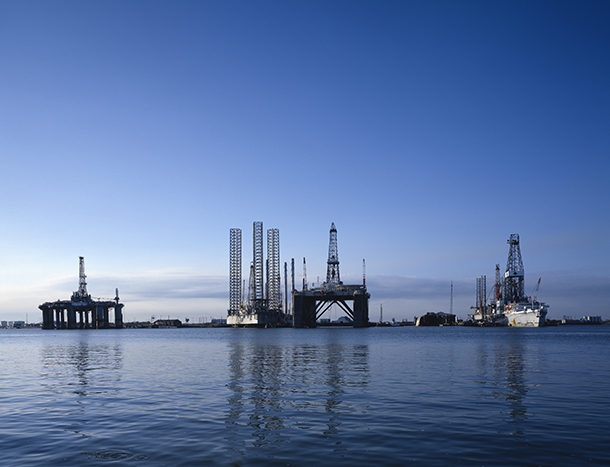
Oil rigs in Galveston, Texas. The number of oil and gas drilling rigs in operation in the U.S. has hit a seventy-year low. (Photo: Carol M. Highsmith/IIP Photo Archive, Flickr CC BY-NC 2.0)
CURWOOD: So, I guess you could do the math here. This is the industry response to low prices and oversupply, huh?
DYKSTRA: Yeah, that would be a safe bet. Nobody’s really saying prices will skyrocket as production slows down, but this is a pretty good sign that the so-called “domestic boom” in oil and gas is either slowing dramatically or ending outright. It also makes the case to open up new oil and gas rigs, whether they’re offshore or on public lands in the Artic or on tar sands deposits in Utah, even more difficult. If oil stays relatively cheap, the oil that’s more expensive to extract is gonna stay in the ground. Just this past week President Obama reversed an earlier decision to offer oil and gas leases in the Atlantic, off the southeast U.S. coast. Governors of several states and, of course, the oil industry were pushing for it. Many coastal residents and, of course, environmental groups were pushing back, and they won.
CURWOOD: But, of course, the next president could change his or her mind. Hey, Peter, before you go, what have do you have for us from the history volume?
DYKSTRA: 15 years ago this week Charles K. Johnson passed away. Mr. Johnson is best known for reviving the fortunes of the International Flat Earth Society, by battling four centuries of heliocentric heresy.
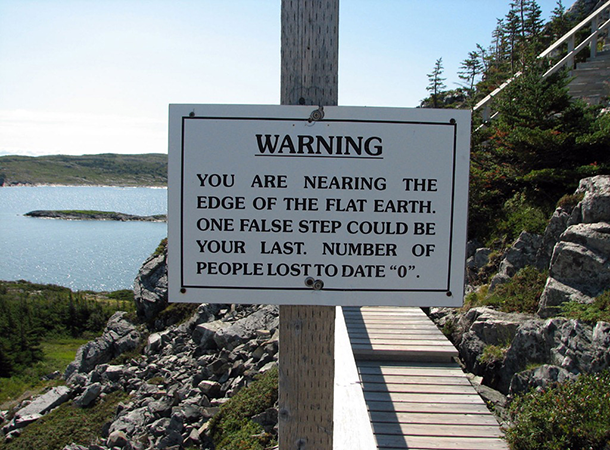
A sign on Fogo Island, off the coast of Newfoundland, pokes some good-natured fun at the now-defunct Flat Earth Society. (Photo: Douglas Sprott, Flickr CC BY-NC 2.0)
CURWOOD: So, President Obama, I recall, compared climate change deniers to the Flat Earth Society, but it’s not just a saying, huh? There really was a Flat Earth Society?
DYKSTRA: There was, and there still is, Steve. They had a dormant period after Mr. Johnson’s death in 2001, but roared back to life a few years later, pressing their case with a wide array of Biblical interpretations that I’m not gonna try to explain because I don’t understand them myself.
CURWOOD: But, wait, uh, there are centuries of findings from Copernicus and Galileo to NASA. I mean, doesn’t that research do the trick for those folks?
DYKSTRA: I’m sure Copernicus and Galileo and NASA all meant well, but sometimes faith is a hard thing to fight. Back in the 1890s a professor Orland Ferguson from Hot Springs, South Dakota, did a brisk business by selling maps of the flat earth by mail order and traveling the U.S., delivering lectures from town to town. I have a modern-day copy of Professor Ferguson’s map right here in my office.
CURWOOD: Hmmm, and I wonder if that crowd thinks that climate change is a hoax, too.
DYKSTRA: I would imagine if you don’t think the Earth is a globe, you can’t really believe that global warming is real.
CURWOOD: [Chuckles.] Peter Dykstra is with Environmental Health News, that’s EHN.org and the Dailyclimate.org. Hey, thanks, Peter. We'll talk to you again soon.
DYKSTRA: OK, Steve. Thank you. Talk to you soon.
CURWOOD: And there’s more on these stories at our website LOE.org.
Related links:
- Outside Guantanamo’s prisons, ‘it’s really a biologist’s dream’
- Pictures of Wildlife in Korea’s Demilitarized Zone
- Hanford and Savannah River sites: “Wildlife finds safe haven on dangerous acres”
- Savannah River Ecology Lab
- About Baker Hughes
- New York Times: Oil and Natural Gas Drilling Rigs Hit 70-Year Low
- USA Today: Obama rejects new Atlantic Ocean oil drilling
- New York Times Obituary: “Charles Johnson, 76, Proponent of Flat Earth”
- Ingenious ‘Flat Earth’ Theory Revealed In Old Map
[MUSIC: Cecil Payne Quartet, “Bosco,” Casbah, Cecil Payne, Stash Records]
CURWOOD: Coming up...it’s a small world after all, and we humans are overexploiting its resources. That's just ahead on Living on Earth. Stay tuned.
ANNOUNCER: Funding for Living on Earth comes from United Technologies, a provider to the aerospace and building systems industries worldwide. UTC Building & Industrial Systems provides building technologies and supplies container refrigeration systems that transport and preserve food and medicine with brands such as Otis, Carrier, Chubb, Edwards and Kidde. This is PRI, Public Radio International.
[CUTAWAY MUSIC: Herb Ellis, “Billie’s Bounce,” Texas Swings, Atlantic Music/Justice Records.]
Big World, Small Planet
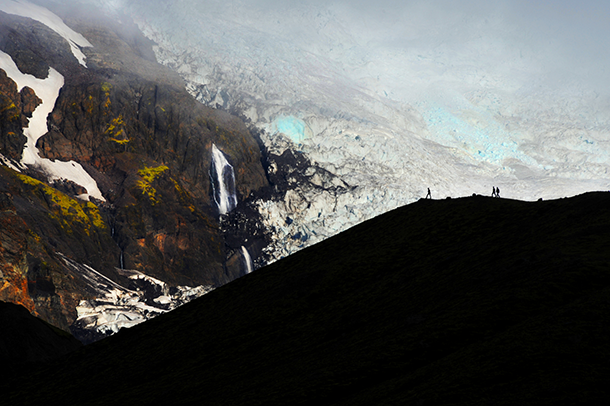
Against the impressive backdrop of a glacier in Iceland, three hikers appear as tiny silhouettes in the cover image of Big World, Small Planet. The book by Johan Rockström and photographer Mattias Klum takes the view that our growing human population can live sustainably on planet Earth, provided that we live within key planetary boundaries. (Photo: Mattias Klum)
CURWOOD: It's Living on Earth, I'm Steve Curwood. More than seven billion humans live on Earth, but collectively we consume so many resources it would take more than one and a half Earths to sustainably supply them. According to Johan Rockström of the Stockholm Resilience Centre we’re rapidly pushing past Earth’s “planetary boundaries”. For example, how much fresh water and nitrogen and phosphorus we can safely use. Given these facts, his new book, a collaboration with photographer Mattias Klum called "Big World, Small Planet", asks us to think seriously about these planetary boundaries. Johan Rockström says the age humans have thrived in, the Holocene, has given us false sense of security, and he joins us now.
ROCKSTRÖM: Thank you.
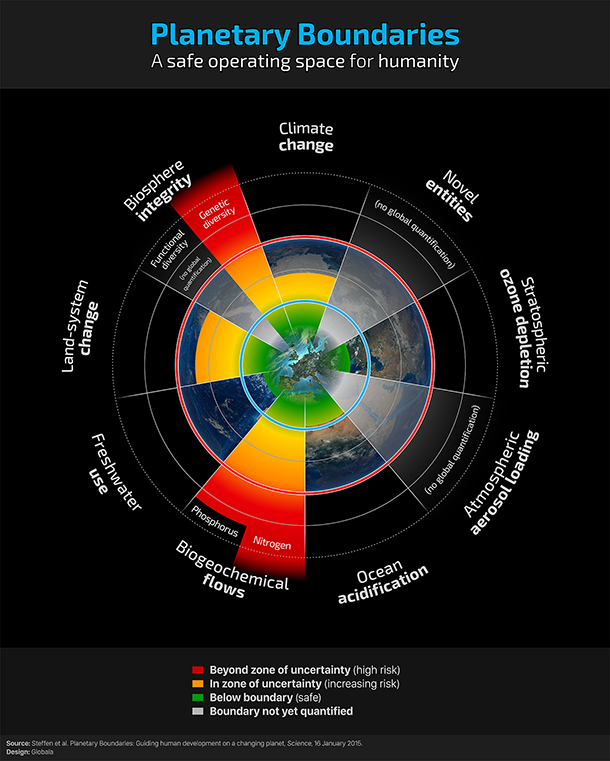
Rockström describes “planetary boundaries” that define the safe operating space in each of nine categories of Earth’s resources. (Photo: Azote Images/Stockholm Resilience Centre)
CURWOOD: Now, one of the strengths of your book, Johan, is that you've done some lot of really terrific math and integrated a bunch of scientific reports and understanding in a way that's really very accessible, but you have a number of concepts that I’d like to talk to you about and one of them is boundaries. What do you mean by boundaries?
ROCKSTRÖM: With the scientific evidence that we can define the desired state of the planet, the stable state of the planet that we need for our survival, the very, very, in a way, obvious scientific question is, “what are the environmental processes that regulates our ability to have a stable planet, and most importantly for each of these processes that regulates the planet, can we define a boundary within which we have a safe operating space?” So the planet has acted equivalent of when you're coming on a very, very meandering road on a mountain area, you have guardrails along that road that allows you to avoid the risk of falling over into an escarpment. So in the same way the planet has guardrails, what we call boundaries, that if you transgress them you risk reinforcing negative changes that could take you to a very, very dangerous situation, but as long as you stay inside, as long as you drive on the road safely within that boundary space, we can have all the opportunity for a thriving, prosperous future.
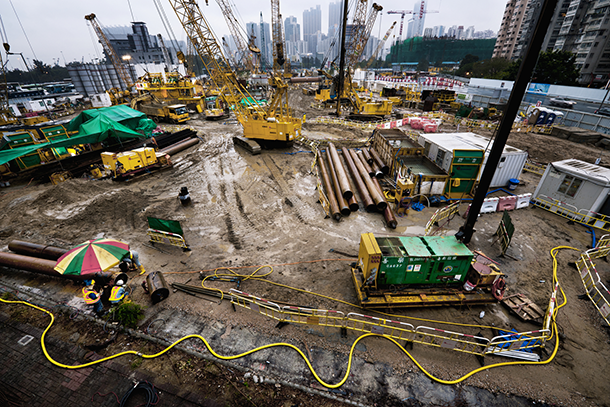
Construction projects like this one in Hong Kong are part of a boom in economic growth and population. Two thirds of the cities the world will need by 2030 have not yet been built. (Photo and caption: Mattias Klum)
CURWOOD: So, you list about nine boundaries in your book, but there are three you call “The Big Three,” and that really get us in a lot of trouble. Briefly what are those?
ROCKSTRÖM: Yes, so we have identified the nine global environmental processes that science shows clearly regulates the ability of the planet to stay in a stable, desired state. Among these nine there are three that have kind of come out as being the fundamental endgame of how all the planetary boundaries operate, and the number one is biodiversity, which is all the living species in what we call the biosphere and all the nature across the planet. We need forests, grasslands, wetlands, coral reefs, all our animals, all our plants, to have a good functioning planet. The second fundamental boundary is climate change. We need a stable climate system because the climate system determines the outcome for all the living species, you and I, animals and plants together. We recently got a very important progress in the global climate agreement in Paris saying that we need to stay within the safe operating space, within the boundary on climate change to one and a half degrees warming as a maximum allowed, as compared to the average temperature before the industrial revolution. And the third of the big three is what we call "novel entities". The totally man-made boundary. It has nothing to do with anything that the planet has ever experienced before, and it is our invention of chemicals, compounds, that are alien to nature like persistent organic pollutants or different kinds of nuclear waste elements that we concentrate in the biosphere and which are at risk of hitting us back through cocktails of chemicals that could, for example, abruptly and very unexpectedly change even the genetic code of different species, including homo sapiens - ourselves. So these are the kind of the three that science has identified as being absolutely critical.
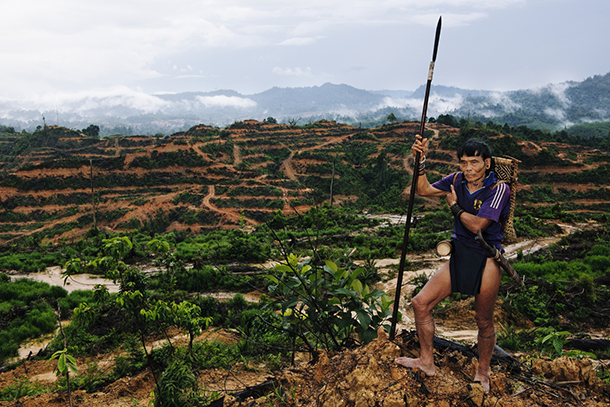
Tebaran, a hunter in Borneo, fears a difficult future for indigenous people as logging operations destroy the rainforest. Deforestation also impacts biodiversity and global climate. (Photo and caption: Mattias Klum)
CURWOOD: So, you're a scientist, Johan, but your book really raises important political and social questions, really, at the end of the day. At one point you note that one nation's unsustainable growth is another nation's threat to growth, and, as you've seen at the climate negotiations, the argument has been that the rich part of the world has conducted a lot of growth unsustainably and threatens the rest of the world. How do you untie this knot?
ROCKSTRÖM: Yeah, I know you're pointing at, if possible, the deep ethical challenge in the climate negotiations and what has been the explanation why the climate negotiations have been so complex over the years because, as you say, the rich minority in the world including countries like my own in Sweden and in the US have benefited from unsustainable use of energy creating huge exponential rise in wealth at the expense of the planet, and moreover we know that the outcome is so unfair because so far the bulk of those causing the problem are not the number one victims of impacts. Now, how are we opening up this? How to break this knot? And we're actually succeeding increasingly, thanks to one reason, which is overall we're finding so much evidence that even African nations, India, China is being more and more convinced about, which is that, why adopt coal-fired plants and oil, natural gas when solar photovoltaics and wind farms and smart biomass grids and electrification seems now to be cheaper and deliver better development simply bypassing the fossil fuel, period. So, in Paris, for example, what we saw for the first time is that all nations, rich and poor, committed very significantly to reducing emissions of greenhouse gases from fossil fuel burning. So that's one key reason, but I'd like to just emphasize that you're absolutely right that the moral imperative remains. The poorest countries in the world still say, you know, we need cheap energy and short-term cheap energy means coal and oil and we therefore need the right to go a bit slower when it comes to reducing our emissions and that is agreed and is even in the climate agreement which actually means - which we tend to forget - that your country, the US, and my country, in Sweden, needs to reduce emissions even faster to allow for a little slower transition in the most developing countries in the world. So that still remains, and that will certainly be a debate in both of our countries, I'm sure.

More than 75 percent of Borneo’s lowland rainforests have been cleared to make way for palm oil plantations. (Photo and caption: Mattias Klum)
CURWOOD: Indeed, and some folks in India are quick to point out that to keep things within the climate boundary that you described, the one and a half degree centigrade rise, there's room perhaps to release another 500 gigatons of carbon into the atmosphere. So, the fairness question comes. Right now the rich part of the world is equipped to keep emitting that carbon, and the poor part of the world really isn't, and that space will get gobbled up in the meantime before places like India, and the Indians have particularly made this argument. How do you regulate that so that in fact, in this last scramble to use the available ability to emit carbon, that there's at least a fair division of those rights?
ROCKSTRÖM: Well, to start with, you're pointing at what I think is perhaps one of the most dramatic and paradigm shifting implications of adopting planetary boundary thinking because, as soon as you accept that planet Earth has biophysical boundaries that we have to respect, that translates to absolute finite budgets that we need to share in a fair way. So, you know, the climate boundary, one and a half degrees Celsius, translates to a global carbon budget, roughly 500 gigatons, billion tons of carbon remaining to be emitted. We're emitting in the order of 30 every year, and that is the big issue that we face today, that if we recognize that we have 500 gigatons roughly remaining to emit, we have to then share this in the fair way, and we have to give China its part, India its part, Angola its part and so on and so forth. And what we find scientifically is that it therefore remains very little for countries like the US or Sweden or the UK or France, and we find that, for example, that we need to decarbonize – “we” meaning in the developed rich world - roughly by 2030, 2040, so 10, 20 years earlier than when the developing world needs to decarbonize. And 2030 is in 14 years, so were talking about an energy revolution, in fact, if we are going to stay true to the climate boundary of one and a half degrees Celsius.
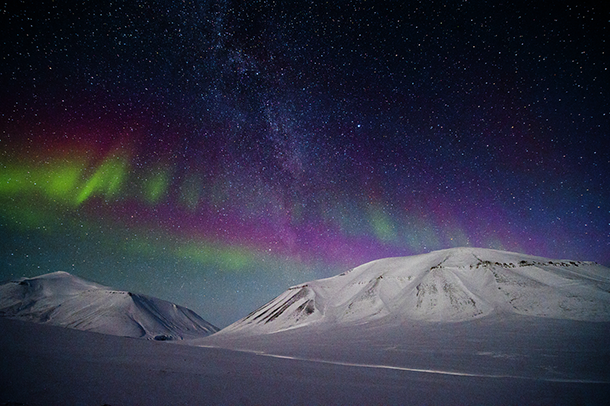
The aurora borealis plays across the sky over Svalbard, an Arctic archipelago. By reflecting sunlight back into space, the white surface of Arctic ice helps to cool the planet. (Photo and caption: Mattias Klum)
CURWOOD: Johan, talk to me about the planetary boundaries when it comes to feeding ourselves. Population is rising, and as you look at some of the limits, planetary limits, we’re already over the line from your perspective on things like phosphorus, the important fertilizer.
ROCKSTRÖM: Oh, that's right and this is such an important question, and the single largest threat to the stability on the planet and the single largest cause, even behind climate change, is agriculture in the world. Some 17 percent of the emission of greenhouse gases originates from how we produce food. The largest cause behind loss of biodiversity is because we're expanding agriculture into natural ecosystems. The largest consumer of freshwater by far is food. Can you believe it? Your and my diet just one day, if we have a little bit of meat on the table, will consume some 3,000 to 4,000 liters of freshwater for one person for one day. And finally there is no food to feed 7.2 billion people unless we use a tremendous amount of nitrogen, through nitrogen fertilizers and phosphorus. When we load too much nitrogen and phosphorus on our land, in our lakes, groundwater, and oceans, they get what we called eutrified, they get saturated with nutrients, and they come to a tipping point and abruptly go from clean water lakes to murky, dead systems that can no longer host living animals and plants. And what we're finding is that an absolutely key strategy to return within a safe operating space on Earth is to transform the world towards sustainable food production, and this challenge is, if anything, perhaps even the largest we face because we know that we're soon nine, ten billion people on Earth, and moreover we have one billion people going hungry every year. So if are serious about eradicating hunger in the world, and we’re serious about feeding a growing population, we will need roughly 50 percent more food production to be able to feed humanity. And our conclusion in the planet boundary analysis is that we can no longer expand agricultural land. We have to feed humanity on the existing land because we cannot lose more nature because nature is such an important habitat and host for biodiversity and sequesters carbon, et cetra, and moreover we need to drastically reduce our use of nitrogen. In fact, our scientific analysis shows we're in such a dangerous zone we have to reduce nitrogen use within the order of 75 percent of phosphorus. We're just at the ceiling of what we can use. We cannot increase that out even further. So this is truly an agenda for a new green revolution, what we called a doubly green revolution. Has to be sustainable, and it has to deliver food for humanity.
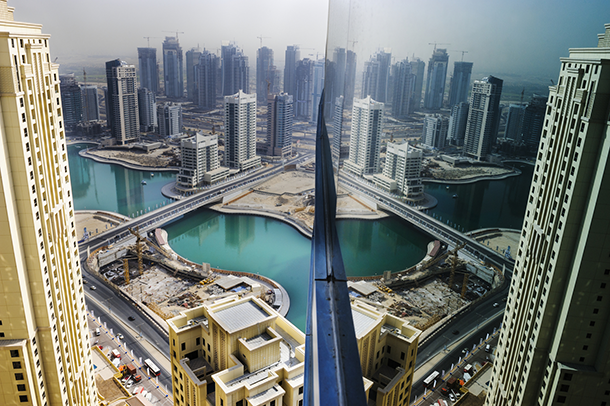
Dubai City, in the United Arab Emirates, reflects the challenges of sustainable urban development -- key to dealing with squeezes from population growth and affluence. (Photo and caption: Mattias Klum)
CURWOOD: So how do we do this? I know it's not fair to ask you. You're the scientist, you've come up with the numbers, the measures, the metrics. But how do you solve this political and social problem that, well, is existential for our civilization.
ROCKSTRÖM: Yeah, it's such a large question, and as you say, I thereby often can say, well, you know I'm an actual scientist and you're going to beyond my responsibilities as an academic. But we need to collectively have a red thread of universal value of us reconnecting with nature and basically become stewards of the remaining beauty on Earth. Now, you will tell me that, “Oh, but all this is naïve and utopia,” and I will answer, “Not necessarily, but it will take a long time before everyone would agree to that universal value.” So in the book we also say we need a fast track because the situation is urgent, and what is that fast track? The fast track is to strengthen global governance to have global rules that are enforced upon all the 200 nations in the world, to show clear signals to corporations, to communities, to mayors and cities to make sure that we are decarbonizing and therefore that is the technological path we're going for corporations. Yes, we are going to safeguard fresh water, so we need to produce food in this and this way. And the good news is, in fact, that last year political leadership actually took a step in that direction. The sustainable development goals adopted by the United Nations is, in fact, adopting a new framework with 17 goals for humanity to say, “Yes, we will eradicate hunger. Yes, we will have poverty alleviation. Yes, we will have good economic development within planetary boundaries.” And the climate agreement was actually setting a very, very, very ambitious step forward towards planetary boundary thinking. So we're starting to see what I think is needed on the short term, which is global enforcement, which is not making life painful for you or me. It's giving boundaries within which we can be successful. So, it's not about, they're saying, “Oh my God, now they're putting this environmental lid on my life and I have to back off and have a worse future. On the contrary, we know that an unsustainable future will give us so many invoices from the Earth system, from the planet, that it makes life more miserable and more difficult. Being sustainable can give us a better life and these boundaries can be regulatory measures from above to steer that.
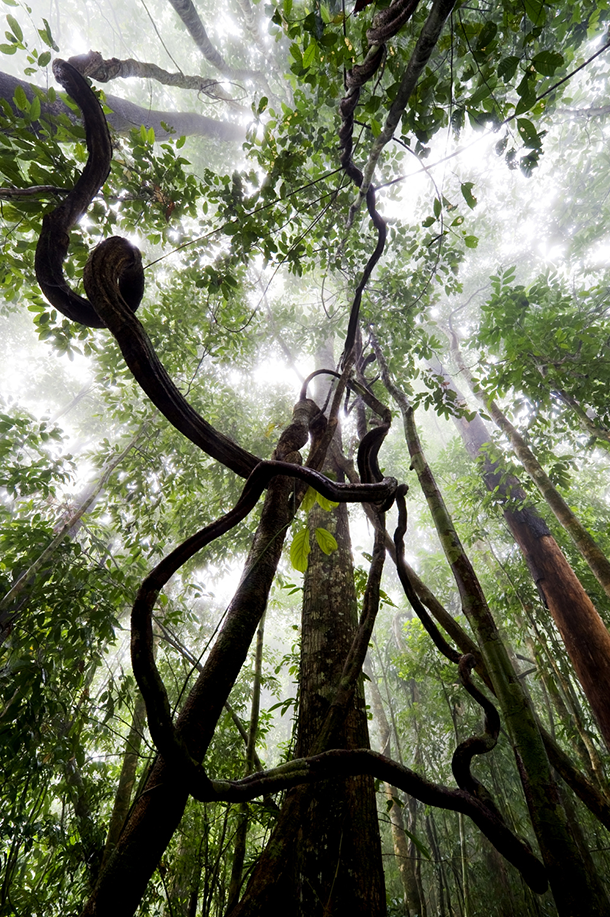
Lianas twine around dipterocarp trees in Malaysia’s Danum Valley Conservation Area. Rainforests provide a vast number of ecosystem services for humanity. (Photo and caption: Mattias Klum)
CURWOOD: So you call this approach, instead of “limits to growth,” “growth within limits,” but some would say you're talking about having world government here.
ROCKSTRÖM: Yes, and if I may or would say that's the wrong interpretation. So definitely we need all of us as a global community to agree on universal rules that apply at the planetary scale. We talk about becoming planetary stewards, we now need to basically govern and set the rules for human behavior on Earth. Now is that a world government? No, it's not. It is, on the short-term, something as simple, still challenging, but still simple of strengthening the United Nations. Why couldn't we in the Security Council in the United Nations take as serious discussions on climate change as we do on ISIS, on biodiversity as we do on Iraq, on freshwater marine systems as we did on the big dilemma with Libya. So you know we would simply need to place up planetary sustainability, from climate to biodiversity, on an equal par with insecurity issues that we deal with so seriously with regards to -- which are very serious -- with regards to terror and war and different, you know, social disruptions, and we can deal with that through global governance. We need enforcement and steering, but that is not about blocking innovation and markets and liberal innovation development, it's rather setting the guardrails within which we can have a good, free, and independent development.
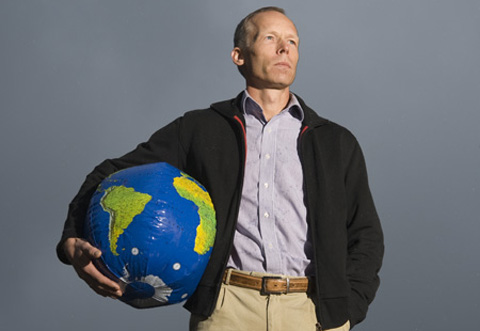
Johan Rockström is a Professor in Environmental Science with emphasis on water resources and global Sustainability at Stockholm University, and the Executive Director of Stockholm Resilience Centre. (Photo: courtesy of Johan Rockström)
CURWOOD: Johan Rockström is co-author of "Big World, Small Planet". Thanks so much for taking the time with us, Professor.
ROCKSTRÖM: Thank you, and a great honor to be on the show.
Related links:
- Big World, Small Planet: Abundance within Planetary Boundaries
- Stockholm Resilience Centre
- Johan Rockström’s TED talk on planetary boundaries
- About Johan Rockström
- Mattias Klum photography
BirdNote: The Florida Scrub-Jay
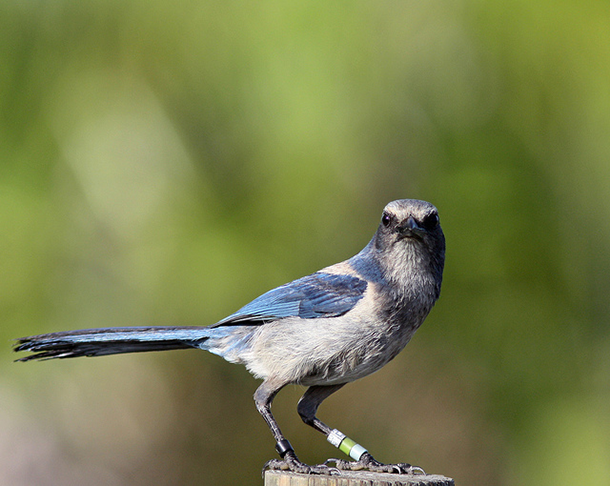
The Florida Scrub-Jay evolved in a time of higher sea levels, when the Florida peninsula was isolated as an island. (Photo: Dan Irizarry)
BIRDNOTE®/SCRUB-JAY
[MUSIC - BIRDNOTE® THEME]
CURWOOD: Off to Florida now – where the seas are rising and much of the land is vulnerable. And as Michael Stein explains in this BirdNote®, one unique ecosystem is especially under threat.
BirdNote®
The Florida Scrub-Jay
[Florida Scrub-Jay calls]
STEIN: One of the rarest natural habitats in America is found in Florida. Thousands of years ago, rising sea levels isolated much of the Florida peninsula as an island. During that long isolation, a unique oak-scrub ecosystem developed. The Florida Scrub-Jay is one among many special animals and plants that evolved with this habitat now protected by the Archbold Biological Station.
[Florida Scrub-Jay calls]

Florida Scrub-Jays live in family groups, and the young of the previous year help raise their younger siblings. (Photo: Eric Kershner)
Eastern Towhees [Eastern Towhee (Florida subspecies) song] and Loggerhead Shrikes are common in the dense scrub habitat [juvenile Loggerhead Shrikes calling]. But unlike the towhee and the shrike, Florida Scrub-Jays are found nowhere else.
Because they’re fascinating birds and quite tame around humans, the jays have been studied for many years. They live in family groups, the young of the previous year helping to raise the current young. This altruistic behavior seemed surprising until studies with banded birds showed that one of the young would immediately take the place of an adult that died.
[Florida Scrub-Jays calling]
Because they depend on acorns during winter, Florida Scrub-Jays can survive only
in oak scrub. Populations have declined by 90% because the birds have lost much of their special habitat to citrus groves, pastures, and development. Now people are working hard to protect what remains.
[Florida Scrub-Jay calls]
I’m Michael Stein.
CURWOOD: For pictures, head on over to our website, LOE.org.
###
Written by Dennis Paulson
Bird sounds provided by The Macaulay Library of Natural Sounds at the Cornell Lab of Ornithology, Ithaca, New York. Calls of Florida Scrub-Jay [138375] recorded by G.F. Budney and [105737] by G.A. Keller; Call notes from Eastern Towhee [105381] recorded by G.A.Keller; and Loggerhead Shrike [105710] recorded by G.A. Keller; group of Florida Scrub-Jays calling [13036] at Archbold Station by K. Worden.
Producer: John Kessler
Executive Producer: Chris Peterson
© Tune In to Nature.org March 2016 Narrator: Michael Stein
A good discussion of Florida Scrub-Jay conservation is at the University of Florida IFAS Extension website (http://edis.ifas.ufl.edu/uw306).
http://birdnote.org/show/florida-scrub-jay
Related links:
- The Florida Scrub-Jay on BirdNote
-
The Florida Scrub-Jay: A Species in Peril”
- About the Florida Scrub-Jay, from the Cornell Lab of Ornithology
[MUSIC: Marina Lebenson, “Lullaby of Birdland,” http://pianistin-lebenson.com/en/, George Shearing/arr.Marina Lebenson]
CURWOOD: Living on Earth is produced by the World Media Foundation. Our crew includes Naomi Arenberg, Bobby Bascomb, Emmett Fitzgerald, Helen Palmer, Adelaide Chen, Jenni Doering, Peter Boucher, Jaime Kaiser, and Jennifer Marquis. Thanks this week to CNN - and we bid farewell today to Lauren Hinkel and wish her well. Tom Tiger engineered our show, with help from John Jessoe, Jake Rego and Noel Flatt. Alison Lirish Dean composed our themes. You can find us anytime at LOE.org, and like us, please, on our Facebook page - it’s PRI’s Living on Earth. And we tweet from @LivingOnEarth. I'm Steve Curwood. Thanks for listening.
ANNOUNCER1: Funding for Living on Earth comes you, our listeners, and from the University of Massachusetts Boston, in association with its School for the Environment, developing the next generation of environmental leaders. And from the Grantham Foundation for the protection of the environment, supporting strategic communications and collaboration in solving the world’s most pressing environmental problems. And Gilman Ordway for coverage of conservation and environmental change. And from SolarCity, America’s solar power provider. Solar city is dedicated to revolutionizing the way energy is delivered by giving customers a renewable alternative to fossil fuels. Information at 888-997-1703. That’s 888-997-1703.
ANNOUNCER2: PRI. Public Radio International.
Living on Earth wants to hear from you!
Living on Earth
62 Calef Highway, Suite 212
Lee, NH 03861
Telephone: 617-287-4121
E-mail: comments@loe.org
Newsletter [Click here]
Donate to Living on Earth!
Living on Earth is an independent media program and relies entirely on contributions from listeners and institutions supporting public service. Please donate now to preserve an independent environmental voice.
NewsletterLiving on Earth offers a weekly delivery of the show's rundown to your mailbox. Sign up for our newsletter today!
 Sailors For The Sea: Be the change you want to sea.
Sailors For The Sea: Be the change you want to sea.
 The Grantham Foundation for the Protection of the Environment: Committed to protecting and improving the health of the global environment.
The Grantham Foundation for the Protection of the Environment: Committed to protecting and improving the health of the global environment.
 Contribute to Living on Earth and receive, as our gift to you, an archival print of one of Mark Seth Lender's extraordinary wildlife photographs. Follow the link to see Mark's current collection of photographs.
Contribute to Living on Earth and receive, as our gift to you, an archival print of one of Mark Seth Lender's extraordinary wildlife photographs. Follow the link to see Mark's current collection of photographs.
 Buy a signed copy of Mark Seth Lender's book Smeagull the Seagull & support Living on Earth
Buy a signed copy of Mark Seth Lender's book Smeagull the Seagull & support Living on Earth

